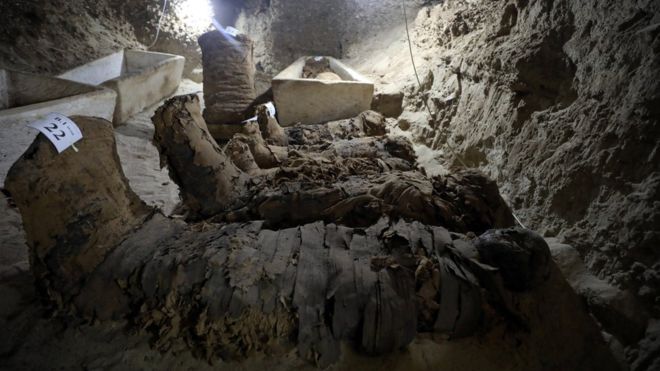Seventeen mummies discovered in Pharaonic cemetery in Minya governorate south of Cairo
 The Egyptian Ministry of Antiquities announced on Saturday that 17 mummies had been found in the vaults of a cemetery in the province of Al-Mina, south of Cairo.
The Egyptian Ministry of Antiquities announced on Saturday that 17 mummies had been found in the vaults of a cemetery in the province of Al-Mina, south of Cairo.
"We found catamarans containing a number of mummies," said Salah al-Khouli, professor of Egyptology at Cairo University and head of the excavation mission that discovered the mummies in the Touna al-Jabal region of central Egypt.
The archaeological mission found holes in the east of the tombs of Touna al-Jabal, leading to "deserts where human mummies were buried," according to the Egyptian Ministry of Antiquities, which confirmed that the tomb included 17 non-royal mummies
The Egyptian Minister of Antiquities, Khalid Anani, said at a press conference held on the site of archaeological discoveries, that the mission revealed "the first human cemetery in Central Egypt, which includes a large number of mummies."
The Egyptian minister pointed out that the first months of 2017 witnessed a number of archaeological discoveries, including the statue of rain and 20 tombs in various archaeological areas.
Dr. Mohammed Hamza, dean of the Faculty of Archeology at Cairo University, explained that this cemetery belongs to the god of the moon and wisdom, which is depicted in the Egyptian antiquities in a number of ways. One of them is a monkey who sits squatting or an ibis, Head this bird.
He pointed out that the excavations had begun in this region since 1931, by the members of the Department of Archeology at the Faculty of Arts.
Jaber Nassar, president of Cairo University, said at the same conference that the excavation mission of the Faculty of Archeology at the university revealed unprecedented archaeological features inside the cemetery, including 12 intact and intact mummies, many mummies and bones, as well as pottery and other items.
Nassar stressed that the university "will continue to finance the archaeological discoveries and support in the mountain tuna to turn it into an important archaeological center on the map of tourism in Egypt."